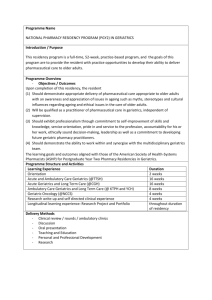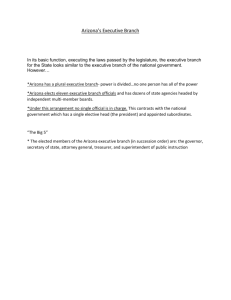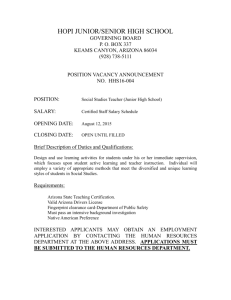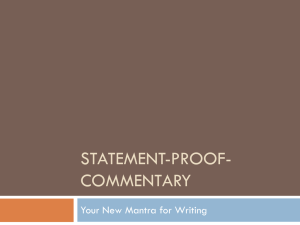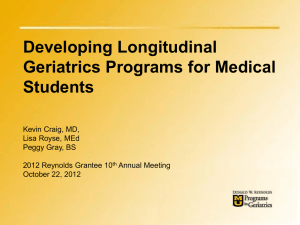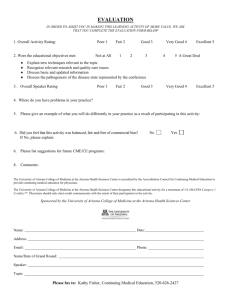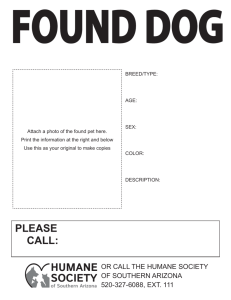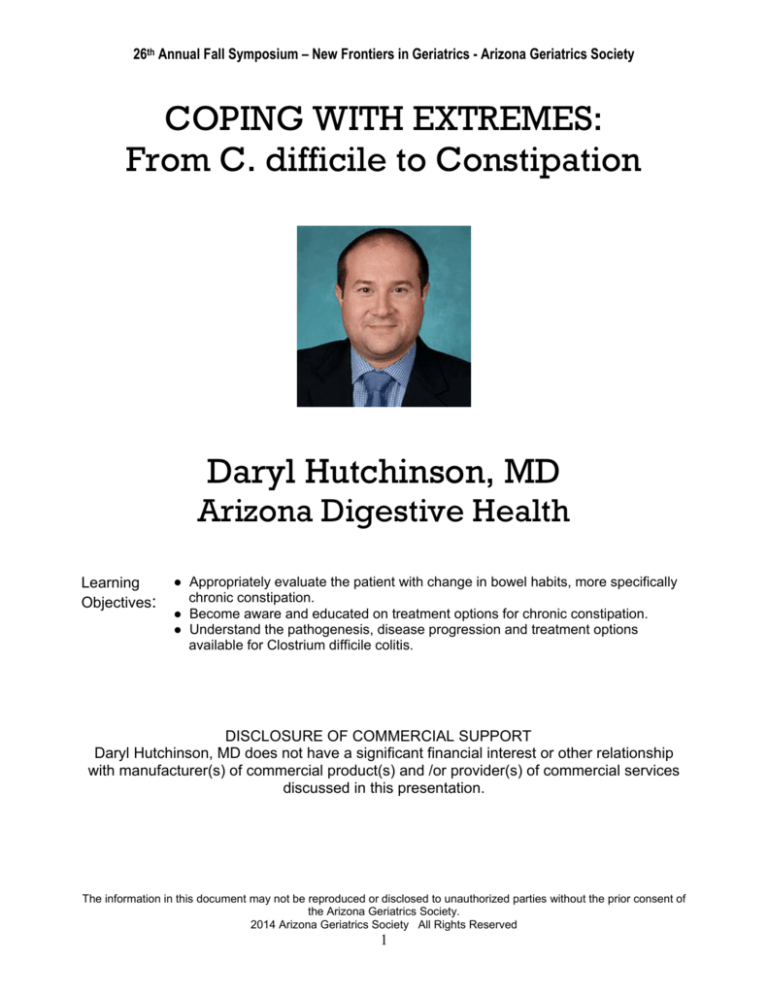
26th Annual Fall Symposium – New Frontiers in Geriatrics - Arizona Geriatrics Society
COPING WITH EXTREMES:
From C. difficile to Constipation
Daryl Hutchinson, MD
Arizona Digestive Health
Learning
Objectives:
● Appropriately evaluate the patient with change in bowel habits, more specifically
chronic constipation.
● Become aware and educated on treatment options for chronic constipation.
● Understand the pathogenesis, disease progression and treatment options
available for Clostrium difficile colitis.
DISCLOSURE OF COMMERCIAL SUPPORT
Daryl Hutchinson, MD does not have a significant financial interest or other relationship
with manufacturer(s) of commercial product(s) and /or provider(s) of commercial services
discussed in this presentation.
The information in this document may not be reproduced or disclosed to unauthorized parties without the prior consent of
the Arizona Geriatrics Society.
2014 Arizona Geriatrics Society All Rights Reserved
1
26th Annual Fall Symposium – New Frontiers in Geriatrics - Arizona Geriatrics Society
___________________________________
___________________________________
Coping with GI Extremes
___________________________________
___________________________________
Daryl S. Hutchinson, M.D.
___________________________________
Clinic for Digestive Diseases, P.C.
A division of
___________________________________
Arizona Digestive Health
Sun City and Surprise, AZ
___________________________________
___________________________________
Epidemiology
___________________________________
• Constipation is a chronic condition causing pain,
reduced ability to function and poor overall general
health
• Estimates of 4-56 million people in the US alone
suffering leading to 2.5 million annual medical visits to a
primary care physician or gastroenterologist
• More common in women & elderly
___________________________________
___________________________________
___________________________________
___________________________________
___________________________________
•
Johanson JF, Sonnenberg A, Koch TR. Clinical epidemiology of chronic constipation. J Clin Gastroenterol. 1989;11:525–536.
•
Stewart WF, Liberman JN, Sandler RS, et al. Epidemiology of constipation (EPOC) study in the United States: relation of clinical subtypes to sociodemographic features. Am J
Gastroenterol. 1999;94:3530–3540
•
Sonnenberg A, Koch TR. Physician visits in the United States for constipation: 1958 to 1986. Dig Dis Sci. 1989;34:606–611
___________________________________
___________________________________
___________________________________
• The prevalence of chronic constipation rises with
age (above 65)
• In this older age group, approximately 26 percent
of men and 34 percent of women complain of
constipation
___________________________________
___________________________________
___________________________________
•
Talley, NJ, Fleming, KC, Evans, JM, et al. Constipation in an elderly community: A study of prevalence and potential risk factors. Am J
Gastroenterol 1996; 91:19.
•
Talley, NJ, O'Keefe, EA, Zinsmeister, AR, Melton, LJ III. Prevalence of gastrointestinal symptoms in the elderly: A population-based study.
Gastroenterology 1992; 102:895.
___________________________________
The information in this document may not be reproduced or disclosed to unauthorized parties without the prior consent of
the Arizona Geriatrics Society.
2014 Arizona Geriatrics Society All Rights Reserved
2
26th Annual Fall Symposium – New Frontiers in Geriatrics - Arizona Geriatrics Society
___________________________________
Definition
___________________________________
• Each patient has there own definition of
___________________________________
•
___________________________________
•
•
•
constipation
Hard stool, discomfort, reduced frequency of
defecation, etc
Many patients denote a change in their frequency
is termed “constipation”
Historically constipation has been interpreted as
stool frequency as little as 3 times per week
Constipation is a symptom complex and not a
disease
___________________________________
___________________________________
___________________________________
___________________________________
Etiology
___________________________________
___________________________________
• Causative or contributing factors are numerous
- Neurogenic/Non-neurogenic
___________________________________
- Drug Induced
___________________________________
- Functional
- Mechanical Obstruction
___________________________________
___________________________________
___________________________________
___________________________________
___________________________________
• Idiopathic causes as well
- normal colonic transit
___________________________________
- slow transit
___________________________________
- dyssynergia (PFD)
___________________________________
___________________________________
The information in this document may not be reproduced or disclosed to unauthorized parties without the prior consent of
the Arizona Geriatrics Society.
2014 Arizona Geriatrics Society All Rights Reserved
3
26th Annual Fall Symposium – New Frontiers in Geriatrics - Arizona Geriatrics Society
___________________________________
Neurogenic Causes
___________________________________
___________________________________
• DM, autonomic neuropathy
• Multiple sclerosis, Parkinson’s disease, SCI
___________________________________
___________________________________
___________________________________
___________________________________
___________________________________
Non-Neurogenic Causes
___________________________________
___________________________________
• Hypothyroidism
• Hypokalemia
• Hypomagnesaemia
___________________________________
___________________________________
___________________________________
___________________________________
___________________________________
Drugs
___________________________________
___________________________________
• Definitely a contributing factor
• Can pose a very challenging dilemma; what to stop,
___________________________________
when to stop, etc
___________________________________
___________________________________
___________________________________
The information in this document may not be reproduced or disclosed to unauthorized parties without the prior consent of
the Arizona Geriatrics Society.
2014 Arizona Geriatrics Society All Rights Reserved
4
26th Annual Fall Symposium – New Frontiers in Geriatrics - Arizona Geriatrics Society
___________________________________
Drugs - Prescription
___________________________________
•
•
•
•
•
•
•
Opiates
Anticholinergics
Antihistamines
Antipsychotics
TCA
Calcium Channel Blockers
Anti Parkinson Agents
___________________________________
•
Locke GR 3rd, Pemberton JH, Phillips SF. AGA technical review on constipation. American Gastroenterological Association. Gastroenterology.
2000;119:1766–1778
___________________________________
___________________________________
___________________________________
___________________________________
___________________________________
Drugs – Nonprescription
•
•
•
•
Calcium-containing antacids
•
Locke GR 3rd, Pemberton JH, Phillips SF. AGA technical review on constipation. American
Gastroenterological Association. Gastroenterology. 2000;119:1766–1778
___________________________________
___________________________________
Calcium supplements
___________________________________
Iron supplements
Anti-diarrheal agents
___________________________________
___________________________________
___________________________________
___________________________________
Clinical Evaluation
___________________________________
• Excellent history
___________________________________
- review of prescribed/non-prescribed drugs
- frequency of defecation
- character of stool
- physical complaints/concerns
- level of inactivity
- accessibility to proper facilities
- psychosocial assessment
- consider “bowel function diary”
___________________________________
___________________________________
___________________________________
___________________________________
The information in this document may not be reproduced or disclosed to unauthorized parties without the prior consent of
the Arizona Geriatrics Society.
2014 Arizona Geriatrics Society All Rights Reserved
5
26th Annual Fall Symposium – New Frontiers in Geriatrics - Arizona Geriatrics Society
___________________________________
Clinical Evaluation
___________________________________
___________________________________
• Degree of straining (? Incomplete evacuation;
possible PF disorder)
___________________________________
• Assess need or requirement for manual pressure or
disimpaction
___________________________________
• What methods of therapy have or are presently being
employed
___________________________________
• Ignoring the urge to defecate
___________________________________
___________________________________
Physical Examination
___________________________________
___________________________________
• Assessment of rectal tone
• Quality of stool in rectal vault
• Rule out distal obstructing lesion
___________________________________
___________________________________
___________________________________
___________________________________
___________________________________
___________________________________
___________________________________
___________________________________
___________________________________
___________________________________
___________________________________
http://gastrolab.1g.fi/ja/a025/slides/5.jpg
The information in this document may not be reproduced or disclosed to unauthorized parties without the prior consent of
the Arizona Geriatrics Society.
2014 Arizona Geriatrics Society All Rights Reserved
6
26th Annual Fall Symposium – New Frontiers in Geriatrics - Arizona Geriatrics Society
___________________________________
Diagnostic Testing
___________________________________
___________________________________
• Electrolytes
• TSH
___________________________________
___________________________________
___________________________________
___________________________________
___________________________________
Diagnostic Testing
___________________________________
• ? Colonoscopy recommended only for patients
___________________________________
• General agreement that that all constipated
___________________________________
displaying evidence of mechanical obstruction
patients >50yrs of age should undergo CRC
screening
___________________________________
• Each case is patient & physician dependent
•
___________________________________
___________________________________
Brenner, DM. Chronic Constipation in 2006: Where we have been, where are we going. The Gastroenterology Report, 2006;1:4-10.
___________________________________
“Red Flags”
___________________________________
• New onset constipation in the elderly
• Severe persistent constipation that is
___________________________________
•
•
•
•
___________________________________
•
•
unresponsive to empiric treatment
Hematochezia
FOBT (+)
Unexplained anemia
Weight loss of 10lbs or more
___________________________________
___________________________________
Cash BD. Fresh perspectives in chronic constipation and other functional bowel disorders. Rev Gastroenterol Disord - 01-JUL-2007; 7(3): 116-33
___________________________________
Brandt LJ, Prather CM, Quigleu EM, et al. Systematic review on the management of chronic constipation in North America. Am J Gastroenterol.
2005:100 (suppl 1):S5-S21.
The information in this document may not be reproduced or disclosed to unauthorized parties without the prior consent of
the Arizona Geriatrics Society.
2014 Arizona Geriatrics Society All Rights Reserved
7
26th Annual Fall Symposium – New Frontiers in Geriatrics - Arizona Geriatrics Society
___________________________________
Diagnostic Testing
•
•
•
•
___________________________________
Colonic Transit Studies
___________________________________
Balloon Expulsion
___________________________________
Anorectal Manometry
___________________________________
Defecography
___________________________________
___________________________________
___________________________________
Evacuation Disorders
___________________________________
___________________________________
• What are some other causes?
___________________________________
• Rectocele
• Foreign devices
• Postsurgical changes
___________________________________
___________________________________
___________________________________
___________________________________
Treatment Options
___________________________________
___________________________________
• Evaluating & treating potentially causative factors
- excluding/treat mechanical obstruction
___________________________________
- discontinuation of medications possibly
precipitating constipation
___________________________________
- dietary/lifestyle modification
___________________________________
- addressing psychosocial issues
- pharmacotherapy
___________________________________
The information in this document may not be reproduced or disclosed to unauthorized parties without the prior consent of
the Arizona Geriatrics Society.
2014 Arizona Geriatrics Society All Rights Reserved
8
26th Annual Fall Symposium – New Frontiers in Geriatrics - Arizona Geriatrics Society
___________________________________
Treatment Options
___________________________________
___________________________________
• Biofeedback therapy
• Surgical options
___________________________________
___________________________________
___________________________________
___________________________________
___________________________________
Mechanical Obstruction
___________________________________
___________________________________
• Colorectal Cancer
• Stricture
• Solitary Rectal Ulcer Syndrome (SRUS)
___________________________________
___________________________________
• Manual disimpaction/fragmentation if indicated
___________________________________
___________________________________
___________________________________
Impaction
___________________________________
• Can use mineral oil enema to soften stool
• Water soluble contrast enema (Gastrograffin) to
___________________________________
exclude proximal obstruction and to eliminate
more proximal impactions
• ? Endoscopic disimpaction
• After disimpaction continue with daily enemas or
oral laxative solution to ensure colon gets
completely evacuated
•
___________________________________
___________________________________
___________________________________
___________________________________
Ward, A. Treatment of constipation in adults. UpToDate Online 17.2
The information in this document may not be reproduced or disclosed to unauthorized parties without the prior consent of
the Arizona Geriatrics Society.
2014 Arizona Geriatrics Society All Rights Reserved
9
26th Annual Fall Symposium – New Frontiers in Geriatrics - Arizona Geriatrics Society
___________________________________
Impaction
___________________________________
___________________________________
• Patient should then be on daily bowel regimen to try
and promote daily bowel movements
___________________________________
• Should use restroom after meals to try and take
advantage of natural gastrocolic reflex
___________________________________
___________________________________
___________________________________
___________________________________
Dietary Changes
___________________________________
___________________________________
• Dietary fiber and bulk laxatives such as psyllium or
methylcellulose, together with adequate fluids, are the
most physiologic and effective approach to therapy,
improving bowel habits in many patients with
constipation
• Wheat bran is one of the more effective fiber
laxatives.
•
___________________________________
___________________________________
___________________________________
Floch, MH, Wald, A. Clinical evaluation and treatment of constipation. Gastroenterologist
1994; 2:50.
___________________________________
___________________________________
___________________________________
• High fiber diet increases stool weight and decreases
___________________________________
• Caution patients that consuming large amounts of
___________________________________
(***from colonic bacterial fermentation***)
___________________________________
colon transit time by stimulating intestinal muscles
fiber can cause abdominal bloating, flatulence –why??
• Recommended daily intake ~25 grams
___________________________________
___________________________________
The information in this document may not be reproduced or disclosed to unauthorized parties without the prior consent of
the Arizona Geriatrics Society.
2014 Arizona Geriatrics Society All Rights Reserved
10
26th Annual Fall Symposium – New Frontiers in Geriatrics - Arizona Geriatrics Society
___________________________________
Bulk Forming Laxatives
___________________________________
• Psyllium, methylcellulose, calcium polycarbophil
• Natural or synthetic polysaccharides or cellulose
___________________________________
derivatives that primarily exert their laxative
effect by absorbing water and increasing fecal
mass
• These laxatives are effective in increasing the
frequency and softening the consistency of stool
with a minimum of adverse effects
___________________________________
•
___________________________________
___________________________________
___________________________________
Ward, A. Treatment of constipation in adults. UpToDate Online 17.2
___________________________________
Bulk Forming Laxatives
___________________________________
___________________________________
• ? Clear benefit
• Most agree that a trial is reasonable
___________________________________
___________________________________
___________________________________
___________________________________
___________________________________
Laxatives
•
•
•
•
___________________________________
Osmotic
___________________________________
Stimulant
___________________________________
Saline
___________________________________
Stool Softeners
___________________________________
___________________________________
http://www.clinicaladvisor.com/fda-approves-linzess-for-ibs-chronic-constipation/article/256919/#
The information in this document may not be reproduced or disclosed to unauthorized parties without the prior consent of
the Arizona Geriatrics Society.
2014 Arizona Geriatrics Society All Rights Reserved
11
26th Annual Fall Symposium – New Frontiers in Geriatrics - Arizona Geriatrics Society
___________________________________
Osmotic Laxatives
___________________________________
• Miralax (PEG 3350)
___________________________________
17grams (1 tblspn) in 8oz water daily
• Lactulose
15-30ml daily up to TID
___________________________________
___________________________________
• Sorbitol 15-30ml BID
___________________________________
Peura DA. PDR Clinical Handbook: chronic Constipation 1st ed. Montvale, NJ: Thomson PDR; 2007
Brandt LJ, Prather CM, Quigleu EM, et al. Systematic review on the management of chronic constipation in North America. Am J
Gastroenterol. 2005:100 (suppl 1):S5-S21.
Ramkumar D, Rao SSC. Efficacy and safety of traditional medical therapies for chronic constipation: systemic review. Am J Gastroenterol.
2005;100:936-971
___________________________________
___________________________________
Osmotic Laxatives
___________________________________
___________________________________
• Poorly absorbed substances draw water into
the lumen of the bowel from the surrounding
tissue along an osmotic gradient.
___________________________________
• This maintains isotonicity with serum plasma,
___________________________________
resulting in increased bulk and a softer stool.
•
___________________________________
Brenner, DM. Chronic Constipation in 2006: Where we have been, where are we going. The Gastroenterology Report, 2006;1:4-10
___________________________________
___________________________________
Osmotic Laxatives
___________________________________
___________________________________
• SE:
- diarrhea
___________________________________
- electrolyte disturbances (K, Na)
___________________________________
PEG does not cause bloating, gas
___________________________________
___________________________________
The information in this document may not be reproduced or disclosed to unauthorized parties without the prior consent of
the Arizona Geriatrics Society.
2014 Arizona Geriatrics Society All Rights Reserved
12
26th Annual Fall Symposium – New Frontiers in Geriatrics - Arizona Geriatrics Society
___________________________________
Saline Laxative
(also osmotic)
___________________________________
___________________________________
• Magnesium hydroxide (MOM)
1-2 tblspn daily or BID
___________________________________
Magnesium Citrate
___________________________________
- onset .5-6hrs
___________________________________
___________________________________
Peura DA. PDR Clinical Handbook: chronic Constipation 1st ed. Montvale, NJ: Thomson PDR; 2007
___________________________________
Stimulant Laxatives
___________________________________
• Senna (Sennokot)
___________________________________
2 tablets daily up to 4 tablets BID
- also in Smooth Move Tea®
- Swiss Kriss®
• Bisacodyl (Dulcolax)
5-15mg daily (po or pr)
___________________________________
___________________________________
stimulate sensory nerves within the colonic mucosa and result in increased
motility
•
Peura DA. PDR Clinical Handbook: chronic Constipation 1st ed. Montvale, NJ: Thomson PDR; 2007
•
Brandt LJ, Prather CM, Quigleu EM, et al. Systematic review on the management of chronic constipation in North America. Am J Gastroenterol. 2005:100 (suppl 1):S5-S21.
•
Brenner, DM. Chronic Constipation in 2006: Where we have been, where are we going. The Gastroenterology Report, 2006;1:4-10.
___________________________________
___________________________________
___________________________________
Stimulant Laxatives
___________________________________
___________________________________
• ? Efficacy
• SE: cramping, diarrhea, hepatotoxicity, electrolyte
___________________________________
imbalances
• ? Enteric nerve damage with subsequent dilation of the
colon and poor motility
___________________________________
• Melanosis coli (senna & cascara – anthraquinonecontaining compounds)
___________________________________
Brenner, DM. Chronic Constipation in 2006: Where we have been, where are we going. The Gastroenterology Report, 2006;1:4-10.
•
Brandt LJ, Prather CM, Quigleu EM, et al. Systematic review on the management of chronic constipation in North America. Am J Gastroenterol.
2005:100 (suppl 1):S5-S21.
•
Xing JH, Soffer E. Adverse effects of laxatives. Dis Colon Rectum. 2001;44:1201–1209.
•
Muller-Lissner SA, Kamm MA, Scarpignato C, Wald A. Myths and misconceptions about chronic constipation. Am J Gastroenterol. 2005;100:232–242.
___________________________________
The information in this document may not be reproduced or disclosed to unauthorized parties without the prior consent of
the Arizona Geriatrics Society.
2014 Arizona Geriatrics Society All Rights Reserved
13
26th Annual Fall Symposium – New Frontiers in Geriatrics - Arizona Geriatrics Society
___________________________________
___________________________________
___________________________________
___________________________________
___________________________________
___________________________________
___________________________________
http://www.gastrohep.com/images_pdfs/images/medium/oepstein.jpg
___________________________________
Stimulant Laxatives
___________________________________
___________________________________
• Some individuals can develop a pyschosocial dependency on
stimulant laxatives
___________________________________
• ? Myenteric nerve damage - ? Neurogenic colon
___________________________________
•
Cash BD. Fresh perspectives in chronic constipation and other functional bowel disorders. Rev Gastroenterol Disord - 01-JUL-2007; 7(3): 116-33
•
Muller-Lissner SA, Kamm MA, Scarpignato C, Wald A. Myths and misconceptions about chronic constipation. Am J Gastroenterol. 2005;100:232-242.
___________________________________
___________________________________
___________________________________
Stool Softeners
___________________________________
• Docusate sodium (Colace )
___________________________________
©
100mg BID
- detergents that lower surface tension of the stool
which causes an increase in water content of the
stool & softens it
- minimal SE
- ? Benefit
- effect in 1-3 days
•
•
___________________________________
___________________________________
___________________________________
Peura DA. PDR Clinical Handbook: chronic Constipation 1st ed. Montvale, NJ: Thomson PDR; 2007
___________________________________
Brenner, DM. Chronic Constipation in 2006: Where we have been, where are we going. The Gastroenterology Report, 2006;1:4-10.
The information in this document may not be reproduced or disclosed to unauthorized parties without the prior consent of
the Arizona Geriatrics Society.
2014 Arizona Geriatrics Society All Rights Reserved
14
26th Annual Fall Symposium – New Frontiers in Geriatrics - Arizona Geriatrics Society
___________________________________
Enemas, Suppositories & Lubricants
___________________________________
___________________________________
• Mineral oil, tap water, glycerin, bisacodyl
___________________________________
•
Peura DA. PDR Clinical Handbook: chronic Constipation 1st ed. Montvale, NJ: Thomson PDR; 2007
___________________________________
___________________________________
___________________________________
___________________________________
Chloride Channel Activator
___________________________________
___________________________________
• Lubiprostone (Amitiza )
©
24 mcg BID with food
___________________________________
• Derived from a metabolite of prostaglandin E1 although it has
no effects on smooth muscle contraction
___________________________________
___________________________________
Peura DA. PDR Clinical Handbook: chronic Constipation 1st ed. Montvale, NJ: Thomson PDR; 2007
•
___________________________________
Cash BD. Fresh perspectives in chronic constipation and other functional bowel disorders. Rev Gastroenterol Disord - 01-JUL-2007; 7(3): 116-33
___________________________________
Chloride Channel Activator
___________________________________
___________________________________
• Type 2 chloride channel (CIC-2) present in luminal
membrane
• Potential to increase chloride and fluid secretion into
lumen
• When activated, chloride and sodium get secreted into
lumen with water passively following to maintain
isotonicity.
• Adds fluid to stool and promotes increased transit
•
___________________________________
___________________________________
___________________________________
___________________________________
Cash BD. Fresh perspectives in chronic constipation and other functional bowel disorders. Rev Gastroenterol Disord - 01-JUL-2007; 7(3): 116-33
The information in this document may not be reproduced or disclosed to unauthorized parties without the prior consent of
the Arizona Geriatrics Society.
2014 Arizona Geriatrics Society All Rights Reserved
15
26th Annual Fall Symposium – New Frontiers in Geriatrics - Arizona Geriatrics Society
___________________________________
Linzess (linactolide)
©
•
•
•
•
___________________________________
Guanylate cyclase-C agonist
___________________________________
145mg/day for CIC
___________________________________
290mg/day for IBS-C
___________________________________
Subsequent elevation in intracellular cGAMP
stimulates secretion of chloride and bicarbonate ions
into intestinal lumen
___________________________________
___________________________________
http://www.frx.com/pi/linzess_pi.pdf
___________________________________
Opioid Antagonists
___________________________________
___________________________________
• Methylnaltrexone
___________________________________
___________________________________
___________________________________
___________________________________
___________________________________
Methylnaltrexone
___________________________________
• Relistor
• Functions as a peripherally-acting mu-opioid
___________________________________
©
receptor antagonist in tissues such as the
gastrointestinal tract, thereby decreasing the
constipating effects of opioids without impacting
opioid-mediated analgesic effects on the central
nervous system.
• Administered subcutaneously
___________________________________
•
___________________________________
___________________________________
___________________________________
"Relistor Full Prescribing Information". http://www.wyeth.com/content/showlabeling.asp?id=499. Retrieved 2009-05-09
The information in this document may not be reproduced or disclosed to unauthorized parties without the prior consent of
the Arizona Geriatrics Society.
2014 Arizona Geriatrics Society All Rights Reserved
16
26th Annual Fall Symposium – New Frontiers in Geriatrics - Arizona Geriatrics Society
___________________________________
Biofeedback Therapy
___________________________________
• Used to correct inappropriate contraction of the pelvic
___________________________________
floor muscles and EAS used during defecation
• Using anal electromyography or sphincter recording
pressures
• Focuses on retraining, relaxation of sphincter and
pelvic floor muscles
• May be effective in more than 70% of patients with
dyssynergic defecation
•
Wald A. Chronic constipation:a guide to modern management.Gastroenterology & Endoscopy News Special Edition.2007:89-96.
•
Cheung O, Wald A. Review article: the management of pelvic floor disorders. Ailment Pharmacol Ther. 2004;19:481-495.
___________________________________
___________________________________
___________________________________
___________________________________
___________________________________
Surgery
___________________________________
___________________________________
• Colectomy with IR anastomosis
- for slow transit constipation
• Repair of rectocele?
• Bloating and abdominal pain are less likely to
improve with surgery.
___________________________________
___________________________________
___________________________________
•
Wald A. Chronic constipation:a guide to modern management.Gastroenterology & Endoscopy News Special Edition.2007:89-96.
•
Knowles CH, Scott M, Lunniss PJ. Outcome of colectomy for slow transit constipation. Ann Surg. 1999;230:627-638.
___________________________________
___________________________________
Complications from Constipation
•
•
•
•
•
•
___________________________________
Stercoral Ulcer
___________________________________
Perforation
___________________________________
Fecal Impaction/Obstruction
___________________________________
Hemorrhoids
Anal Fissures
___________________________________
Prolapse
___________________________________
The information in this document may not be reproduced or disclosed to unauthorized parties without the prior consent of
the Arizona Geriatrics Society.
2014 Arizona Geriatrics Society All Rights Reserved
17
26th Annual Fall Symposium – New Frontiers in Geriatrics - Arizona Geriatrics Society
___________________________________
___________________________________
___________________________________
Clostridium difficile
___________________________________
___________________________________
___________________________________
___________________________________
___________________________________
Basics
___________________________________
___________________________________
• What is Cdiff?
• Gram +
• Anaerobe
• Spore forming bacillus (spores can live awhile
___________________________________
___________________________________
outside the human body)
___________________________________
___________________________________
___________________________________
___________________________________
___________________________________
• Produces two exotoxins
• Responsible for up to 15-25% of all antibiotic
associated diarrheas, 50% to 75% of those with
antibiotic-associated colitis, and more than 90%
of those with antibiotic-associated
pseudomembranous colitis
___________________________________
• Important hospital-acquired infection associated
___________________________________
___________________________________
with an increase in length of hospital stay and
cost, and substantial morbidity and mortality.
___________________________________
The information in this document may not be reproduced or disclosed to unauthorized parties without the prior consent of
the Arizona Geriatrics Society.
2014 Arizona Geriatrics Society All Rights Reserved
18
26th Annual Fall Symposium – New Frontiers in Geriatrics - Arizona Geriatrics Society
___________________________________
Basics
___________________________________
___________________________________
• Spores survive gastric acidity
• In small intestine, spores convert into their vegetative
___________________________________
state
• In the colon, normal flora has been disrupted by Abx
___________________________________
and spores germinate and flourish
___________________________________
___________________________________
___________________________________
What can it do??
•
•
•
•
•
___________________________________
pseudomembranous colitis (PMC)
___________________________________
toxic megacolon
___________________________________
perforations of the colon
___________________________________
sepsis
death (rarely)
___________________________________
___________________________________
___________________________________
Symptoms
•
•
•
•
•
___________________________________
watery diarrhea
___________________________________
fever
___________________________________
loss of appetite
___________________________________
nausea
abdominal pain/tenderness
___________________________________
___________________________________
The information in this document may not be reproduced or disclosed to unauthorized parties without the prior consent of
the Arizona Geriatrics Society.
2014 Arizona Geriatrics Society All Rights Reserved
19
26th Annual Fall Symposium – New Frontiers in Geriatrics - Arizona Geriatrics Society
___________________________________
Risk factors
•
•
•
•
•
•
•
___________________________________
___________________________________
antibiotic exposure
proton pump inhibitors
___________________________________
gastrointestinal surgery/manipulation
long length of stay in healthcare settings
___________________________________
a serious underlying illness
___________________________________
immunocompromising conditions
advanced age
___________________________________
___________________________________
Is it there? Is active?
___________________________________
___________________________________
• Clostridium difficile colonization
• patient exhibits NO clinical symptoms
• patient tests positive for Clostridium difficile organism and/or its
___________________________________
toxin
• more common than Clostridium difficile infection
• Studies show that colonization in LTCF can be up to 20%!!
___________________________________
___________________________________
• Clostridium difficile infection
• patient exhibits clinical symptoms
• patient tests positive for the Clostridium difficile organism and/or its
___________________________________
toxin
___________________________________
How did I get this???
___________________________________
___________________________________
• Shed in feces
• Any device contaminated with feces can transmit it
• Clostridium difficile spores are transferred to patients mainly
___________________________________
via the hands of healthcare personnel who have touched a
contaminated surface or item
___________________________________
• The estimated prevalence of C. difficile colonization may be
___________________________________
as high as 50% in hospitalized patients where CDI is
endemic, 5% to 7% in residents of long-term care
facilities, and generally less than 2% in ambulatory adults.
___________________________________
The information in this document may not be reproduced or disclosed to unauthorized parties without the prior consent of
the Arizona Geriatrics Society.
2014 Arizona Geriatrics Society All Rights Reserved
20
26th Annual Fall Symposium – New Frontiers in Geriatrics - Arizona Geriatrics Society
___________________________________
___________________________________
___________________________________
___________________________________
___________________________________
___________________________________
___________________________________
http://www.clevelandclinicmeded.com/medicalpubs/diseasemanagement/infectious-disease/clostridium-difficile-infection/
___________________________________
___________________________________
• The 1st step is alteration of the normal gut flora, usually as a
___________________________________
• Clindamycin was the first antibiotic to be associated with
___________________________________
• Since that initial observation, almost all antimicrobials have
___________________________________
• Chemotherapeutic agents, particularly those with antimicrobial
___________________________________
result of administration of an antibiotic.
pseudomembranous colitis, identified as a precipitant before the
establishment of C. difficile as the causal pathogen.
been associated with CDI including cephalosporins, penicillins,
and the fluoroquinolones.
properties, have also been associated with the development of
CDI
___________________________________
http://www.clevelandclinicmeded.com/medicalpubs/diseasemanagement/infectious-disease/clostridium-difficile-infection/
___________________________________
___________________________________
___________________________________
• The second step is acquisition of a toxigenic strain of C. difficile.
• The organism is primarily a nosocomially acquired pathogen
___________________________________
and its spores can be found in the hospital environment
• Once a patient has acquired C. difficile, he or she will develop
clinical disease or will remain asymptomatically colonized, the
final step in the process.
___________________________________
• Although the exact incubation time for CDI is unknown, the
___________________________________
time from acquisition to disease is relatively short, perhaps no
longer than 7 days
___________________________________
The information in this document may not be reproduced or disclosed to unauthorized parties without the prior consent of
the Arizona Geriatrics Society.
2014 Arizona Geriatrics Society All Rights Reserved
21
26th Annual Fall Symposium – New Frontiers in Geriatrics - Arizona Geriatrics Society
___________________________________
Treatment
___________________________________
___________________________________
• In about 20% of patients, Clostridium difficile infection will
resolve within 2-3 days of discontinuing the antibiotic to
which the patient was previously exposed.
___________________________________
• The infection can usually be treated with an appropriate
course (about 10-14 days) of antibiotics, including
metronidazole, vancomycin (administered orally), or
recently approved fidaxomicin.
___________________________________
___________________________________
• After treatment, repeat Clostridium difficile testing is not
recommended if the patients’ symptoms have resolved, as
patients may remain colonized
___________________________________
___________________________________
How can we prevent this
___________________________________
___________________________________
• Use antibiotics judiciously (are they truly necessary?)
• Use Contact Precautions: for patients with known or suspected
___________________________________
Clostridium difficile infection; can stop when diarrhea ceases
• Because alcohol does not kill Clostridium difficile spores, use of
soap and water is more efficacious than alcohol-based hand
rubs.
• Use gowns when entering patients’ rooms and during patient care.
• Dedicate or perform cleaning of any shared medical equipment
___________________________________
___________________________________
___________________________________
___________________________________
___________________________________
___________________________________
• Continue these precautions until diarrhea ceases.
• Because Clostridium difficile-infected patients continue to
___________________________________
shed organism for a number of days following cessation of
diarrhea, some institutions routinely continue isolation for
either several days beyond symptom resolution or until
discharge, depending upon the type of setting and average
length of stay.
___________________________________
___________________________________
• Cleansing programs at institutions
___________________________________
The information in this document may not be reproduced or disclosed to unauthorized parties without the prior consent of
the Arizona Geriatrics Society.
2014 Arizona Geriatrics Society All Rights Reserved
22
26th Annual Fall Symposium – New Frontiers in Geriatrics - Arizona Geriatrics Society
___________________________________
Diagnosis
___________________________________
___________________________________
• Stool analysis: PCR (highly specific and sensitive)
• What about sigmoidoscopy or colonoscopy?
___________________________________
• When should this be done??
___________________________________
___________________________________
___________________________________
___________________________________
Endoscopic view….
___________________________________
___________________________________
___________________________________
___________________________________
___________________________________
___________________________________
http://www.langetextbooks.com/0071774343/gallery.php?id=o-p
___________________________________
Treatment
___________________________________
___________________________________
• Historically, as many as 50% of patients will respond
to stopping the precipitating antibiotic, however the
emerging trends of CDI demonstrate that this is a
potentially devastating infection that requires
treatment.
___________________________________
___________________________________
• Adequate hydration and electrolyte replenishment
should accompany medical and surgical therapy.
___________________________________
• Antiperistaltics should be avoided because these can
exacerbate toxin-mediated damage to the mucosa.
___________________________________
The information in this document may not be reproduced or disclosed to unauthorized parties without the prior consent of
the Arizona Geriatrics Society.
2014 Arizona Geriatrics Society All Rights Reserved
23
26th Annual Fall Symposium – New Frontiers in Geriatrics - Arizona Geriatrics Society
___________________________________
Treatment
___________________________________
___________________________________
• Metronidazole (500mg 1 po TID or IV for 2 weeks)
• Effective, comparable to vancomycin but less expensive
___________________________________
(and less chance of developing VRE!)
• Oral vanco used for intolerance to metronidazole, lack of
___________________________________
response to metronidazole or more severe disease
• No documented resistance to these two drug by Cdiff
___________________________________
• When should we start seeing results??
___________________________________
• Hopefully by a few days
___________________________________
Treatment
___________________________________
___________________________________
• Severe disease
• Can use vanco enemas
___________________________________
• May need surgical eval
___________________________________
___________________________________
___________________________________
___________________________________
Treatment
•
•
•
•
___________________________________
IVIG
___________________________________
Probiotics
___________________________________
Fidaxomicin (Dificid)
___________________________________
Rifaximin: Small case series have suggested that
sequential therapy with vancomycin followed by
rifaximin may be effective for the treatment of
recurrent CDI [
___________________________________
___________________________________
The information in this document may not be reproduced or disclosed to unauthorized parties without the prior consent of
the Arizona Geriatrics Society.
2014 Arizona Geriatrics Society All Rights Reserved
24
26th Annual Fall Symposium – New Frontiers in Geriatrics - Arizona Geriatrics Society
___________________________________
Recurrence
___________________________________
___________________________________
• 20%after 1st episode
• 45% after 1st recurrence
• 65% after 2 or more recurrences
___________________________________
___________________________________
___________________________________
___________________________________
___________________________________
Recurrence
___________________________________
___________________________________
• Historically, we are taught to give another trial of
what we first tried
___________________________________
• CDI can recur after treatment with metronidazole or
vancomycin with rates ranging from 15% to 30%
___________________________________
• After the first relapse; prolonged vanco taper is
recommended
___________________________________
___________________________________
___________________________________
___________________________________
___________________________________
___________________________________
___________________________________
___________________________________
___________________________________
The information in this document may not be reproduced or disclosed to unauthorized parties without the prior consent of
the Arizona Geriatrics Society.
2014 Arizona Geriatrics Society All Rights Reserved
25
26th Annual Fall Symposium – New Frontiers in Geriatrics - Arizona Geriatrics Society
___________________________________
Fecal Transplant
___________________________________
___________________________________
• Fecal bacteriotherapy
• Attempts to reconstitute the protective flora with
___________________________________
fecal infusions via nasogastric tube or rectally have
been reported to have great success
___________________________________
___________________________________
___________________________________
http://www.clevelandclinicmeded.com/medicalpubs/diseasemanagement/infectious-disease/clostridium-difficile-infection/
___________________________________
Toxic Megacolon
___________________________________
___________________________________
___________________________________
___________________________________
___________________________________
___________________________________
http://graphicwitness.medicalillustration.com/generateexhibit.php?ID=69184
___________________________________
Toxic Megacolon
___________________________________
___________________________________
___________________________________
___________________________________
___________________________________
___________________________________
http://o.quizlet.com/4.GEfAuLHm7ncGlt1lG1lg_m.png
The information in this document may not be reproduced or disclosed to unauthorized parties without the prior consent of
the Arizona Geriatrics Society.
2014 Arizona Geriatrics Society All Rights Reserved
26
26th Annual Fall Symposium – New Frontiers in Geriatrics - Arizona Geriatrics Society
___________________________________
Surgery
___________________________________
___________________________________
• Early surgical consultation should be considered for
severe CDI, especially if toxic megacolon is present,
because operative intervention can be lifesaving.
___________________________________
• Various surgical procedures have been described,
___________________________________
including diversion of fecal stream by ileostomy,
decompressive colostomy, or subtotal colectomy, the
procedure of choice with toxic megacolon.
___________________________________
• Cases requiring surgery carry high mortality rates,
ranging from 30% to over 50%
___________________________________
http://www.clevelandclinicmeded.com/medicalpubs/diseasemanagement/infectious-disease/clostridium-difficile-infection/
___________________________________
___________________________________
___________________________________
Thank You
___________________________________
___________________________________
___________________________________
___________________________________
The information in this document may not be reproduced or disclosed to unauthorized parties without the prior consent of
the Arizona Geriatrics Society.
2014 Arizona Geriatrics Society All Rights Reserved
27

